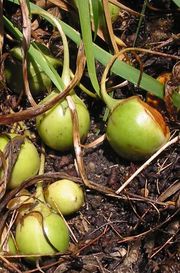Mandragora officinarum
| Mandragora officinarum subsp. var. | ||||||||||||||||||||||||||||||||||||||||||||||||||||||||
|---|---|---|---|---|---|---|---|---|---|---|---|---|---|---|---|---|---|---|---|---|---|---|---|---|---|---|---|---|---|---|---|---|---|---|---|---|---|---|---|---|---|---|---|---|---|---|---|---|---|---|---|---|---|---|---|---|

|
|
| ||||||||||||||||||||||||||||||||||||||||||||||||||||||
| ||||||||||||||||||||||||||||||||||||||||||||||||||||||||
Perennial growing to 0.1m by 0.3m . It is hardy to zone 7 and is not frost tender. It is in leaf from March to July, in flower from March to April, and the seeds ripen from July to August. The flowers are hermaphrodite (have both male and female organs) and are pollinated by Insects. The plant is self-fertile.
| Standard Cyclopedia of Horticulture |
|---|
|
Mandragora officinarum, Linn. (M. officinalis, Mill. Atropa Mandragora, Linn.). Mandrake. Lvs. ovate, the first obtuse, the others acuminate: calyx-teeth lanceolate, as long as the oblong berry.
|
Cultivation
The plant prefers light (sandy) and medium (loamy) soils and requires well-drained soil. The plant prefers acid and neutral soils. It can grow in semi-shade (light woodland) or no shade. It requires dry or moist soil.
Prefers a deep humus-rich light soil and a sheltered position in full sun. It also tolerates some shade. Prefers a circumneutral soil and dislikes chalk or gravel. Plants are liable to rot in wet or ill-draining soils.
The roots are somewhat carrot-shaped and can be up to 1.2 metres long. Plants are intolerant of root disturbance and should be put out into their permanent positions as soon as possible.
The root often divides into two and is vaguely suggestive of the human body. In the past it was frequently made into amulets which were believed to bring good fortune, cure sterility etc. There is a superstition that if a person pulls up this root they will be condemned to hell. Therefore in the past people have tied the roots to the bodies of animals and then used these animals in order to pull the roots out of the soil.
Propagation
Seed - best sown in a cold frame in the autumn. The seed can also be sown in spring in a cold frame. When they are large enough to handle, prick the seedlings out into individual pots and grow them on in the greenhouse for at least their first winter. Plant them out into their permanent positions in late spring or early summer, after the last expected frosts.
Root cuttings in winter.
Pests and diseases
Varieties
Gallery
-
photo 1
-
photo 2
-
photo 3
References
- Standard Cyclopedia of Horticulture, by L. H. Bailey, MacMillan Co., 1963
External links
- w:Mandragora officinarum. Some of the material on this page may be from Wikipedia, under the Creative Commons license.
- Mandragora officinarum QR Code (Size 50, 100, 200, 500)
